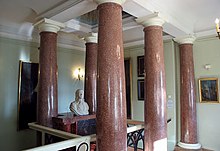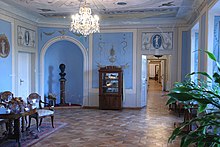Śmiełów
| Śmiełów | ||
|---|---|---|

|
|
|
| Basic data | ||
| State : | Poland | |
| Voivodeship : | Greater Poland | |
| Powiat : | Jarocin | |
| Gmina : | Żerków | |
| Geographic location : | 52 ° 7 ′ N , 17 ° 34 ′ E | |
| Residents : | 260 | |
| Postal code : | 63-210 | |
| License plate : | PJA | |

Śmiełów [ 'ɕmʲɛwuf ] (German Smielow ) is a village with 260 inhabitants in western Poland and part of the municipality Żerków . It is located about 60 km southeast of Poznan and 10 km north of Jarocin in the Greater Poland Voivodeship and belongs to the Jarociński powiat .
history
In the Middle Ages Śmiełów was owned by the important Polish noble family the Górka, later it belonged to the Radomicki. The noble Gorzeński family from Dobrzyca bought the village in 1784 , and Andrzej Gorzeński, judge at the Poznan Voivodeship Court, built the ensemble of aristocratic castle and landscape park at the end of the 18th century .
After Śmiełów came under Prussian rule as a result of the Second Partition of Poland, first in 1793 and then again after the Congress of Vienna in 1815 , the town and castle became an important address for Polish independence efforts. In 1831 Poland's national poet Adam Mickiewicz stayed here for several weeks because he was considering taking part in the Polish November Uprising. In the following decades, the owners of Śmiełów collected an extensive collection of valuable memorabilia from the poet. Throughout the 19th century , Śmiełów served as a transshipment point for people, writings and goods between the Prussian and Russian partitions of Poland.
In 1887 the Gorzeński family died out and the landed aristocrat Franciszek Chełkowski acquired the indebted property. The Chełkowski breed horses , transform Śmiełów into an “open house” and count among their guests the pianist and first Prime Minister of the resurrected Poland Ignacy Jan Paderewski , the writer Henryk Sienkiewicz , the philosopher Władysław Tatarkiewicz and General Józef Haller .
Śmiełów returned to Poland together with the rest of Greater Poland in 1918 . The Second World War and the immediate post-war period resulted in considerable damage to the property. In 1970 the Poznan National Museum became the owner of the facility, began its thorough restoration and reopened it as a museum in 1975 .
Attractions
The main attraction at the site is the castle with its landscape park. Like the Rogalin castles (45 km to the north-west) and Gołuchów (45 km to the southeast), the Śmiełów complex is part of the Poznan National Museum . It was also built by the same noble family and the same architect as the castle in Dobrzyca, 25 km to the south .
lock
The castle was built around 1797 and was designed by the important Polish builder Stanisław Zawadzki on behalf of Andrzej Gorzeński . It is a two-story, square main building, which is connected by galleries with two side wings. Similar to Rogalin, the main building, side wings and galleries form the horseshoe-shaped border of a court of honor, the main optical accent of which is the portico of the main building - a distinctive feature of the vast majority of Polish aristocratic residences. The arrangement of the salons and other rooms inside the castle is partly asymmetrical; this creates an atmosphere that blurs vaguely into the mysterious and suggests romanticism . In the basement is a achtwandiger Gewölbesaal important that in the 18th and 19th century, a lodge of Freemasons served as a meeting place.
Adam Mickiewicz Museum
As part of the National Museum in Poznan, the rooms of the castle can be visited. The exhibition is dedicated to the stay here of the great romantic poet Adam Mickiewicz in 1831 . On display are original manuscripts , letters and other manuscripts, portraits of the poet, as well as images and texts that illustrate the Mickiewicz cult of the late 19th and early 20th centuries (including by Wojciech Kossak ). Most of the collections come from the possession of the Gorzeński and Chełkowski family, as do some of the Biedermeier furniture on display . Paintings from the French , Dutch , Italian and German schools from the 16th to 18th centuries are also on view from the holdings of the National Museum, so that overall an adequate impression of life in an upper-class Polish country estate from the Mickiewicz period is conveyed.
Landscape park
The palace park was laid out at the same time as the palace was built. It is a 5.5 hectare landscape park in the English style , through which a tributary of the Lutynia flows. The chestnut avenues , a natural river island, an orangery , a lapidarium and the part of the park known as Ogródek Zosi ("Sophie (Zosia's) garden") with sculptures are particularly beautiful . Outside the park there are historical farm buildings of the former estate.
Nature reserve
The castle and park are located in the middle of the Żerkowsko-Czeszewski Park Krajobrazowy ( Żerków-Czeszew Nature Park ), which was established in 1994 and covers an area of 156.4 km² and protects the floodplains on the Warta and Lutynia as well as ice-age landscapes. Endangered bird species nest in three separate reserves.
Web links
- Website with information about Śmiełów Castle - Polish (plans, floor plans, pictures)
- National Museum Poznan, Śmiełów Department - Polish (information and pictures)



